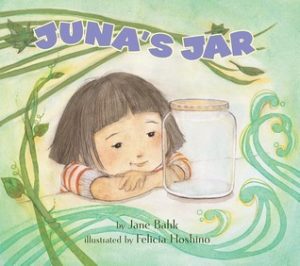 Juna’s Jar / El frasco de Juna
Juna’s Jar / El frasco de Juna
Written by Jane Bahk
Illustrated by Felicia Hoshino
Lee & Low Books, 2015, 32 pp (unpaged)
ISBN: 978-1620148310 (English)
ISBN: 978-1643796192 (Spanish, 2022)
“Juna’s jar was empty again. (n.p).”
Juna loves to take her empty kimchi jar on adventures. Sometimes she and her best friend Hector let plants and small insects live inside the empty kimchi jar. Afterwards, they release the resident of the jar. One morning, Juna receives the news that her best friend has moved far away. When Juna sadly returns home, her older brother Minho tries to cheer her up and takes his younger sister to Mr. Lee’s pet shop. Minho buys a small fish for Juna to raise in her empty jar. When her fish grows too big to reside in the jar, Juna puts it in an aquarium with Minho’s help. Afterwards, Minho gives his younger sister a small bean plant he had grown for his science class, and they carefully plant it in her empty jar. That night, Juna climbs down the plant and enters a rainforest to look for Hector. During her journey, Juna encounters various animals and she wishes Hector was with her because he knows a lot about them. Eventually, the plant grows too big for Juna’s jar so Minho helps her move it into a large pot.
With the empty kimchi jar, the siblings create a home for a cricket they found at the park. When everyone is asleep that evening, the cricket takes Juna for a ride, and they fly through the evening sky together until they land on the window sill of a big house. In that moment Juna finds Hector and notices that he has kept a kimchi jar she had given him on his bedside table. She watches him through the window and whispers goodbye before she returns home by riding on the cricket’s back. Later, Minho and Juna release the cricket because it grows too big. Juna’s jar becomes empty once again. When Juna wonders what to put next in her container, a girl with a green inch worm on her arm asks about placing the insect in Juna’s jar. The story ends with Juna happily holding out her empty kimchi jar towards the girl.
With regards to cultural authenticity, there are several written and visual cues that portray Juna and her brother as Asians, specifically Koreans or Korean Americans. For example, their names, facial attributes, and their family’s enjoyment of kimchi. Additionally, Juna’s interaction with nature is somewhat similar to Korean traditional folktales in ways that animals and insects offer their assistance to return the kindness they received from the protagonist for taking care of them in her jar. There are also Korean cultural elements embedded in the text, especially in the repeated sentence, “Juna’s jar was empty again” because there is a Korean philosophy that one is able to gain when there is nothing. Likewise, letting go creates room for something new, and this cycle in life is presented through the illustrations of the round jar. Thus, this sentence provides hints to the readers that the empty jar will lead Juna to a new adventure. Both texts and illustrations from the story vividly convey the adventures Juna experienced. They also portray Juna’s longing to be with her best friend Hector. The gentle watercolor illustrations present the characters’ expressions and emotions smoothly, even for the animals in this story.
In addition, Juna’s friendship with Hector appears to be interracial as Juna and Hector’s grandmothers greet each other in Spanish. However, there is not enough information about how Juna and Hector developed their friendship, including whether or not they may speak a language other than English.
Juna’s Jar would make a great pair with Memory Jars by Vera Brosgol (2021) and Idea Jar by Adam Lehrhaupt (2018). Additionally, The Name Jar by Yangsook Choi (2003), Kindness Snippet Jar by Diane Alber (2019), and The Blessings Jar: A Story About Being Thankful by Colleen Coble (2013) would also make excellent additions. With the use of the jar as a theme, educators, parents, and students would be able to engage in discussions about how this universal container is used across various cultures. Moreover, they could share stories together and create ways to utilize jars for fun learning activities.
The acclaimed Korean American children’s book author Jane Bahk (a.k.a. Jane Park), is an award-winning media producer and a former school teacher who lives with her family in the San Francisco Bay Area. Her inspiration to write Juna’s Jar came from her own fond memories of playing with empty kimchi jars. She especially likes good adventures that involve her kids and their jars. More information about the works by Jane Park can be found online at her website.
The Japanese American illustrator, Felicia Hoshino, was born in San Francisco, California where she continues to live with her family. She earned a BFA in illustration at California College of the Arts and is an award-winning illustrator and graphic designer. She enjoys cooking with her husband and decorating their house walls with art that their daughter and son create. Additional information about Felicia Hoshino can be found online at her website.
Hyunjung Lee, University of Arizona
© 2023 by Hyunjung Lee

